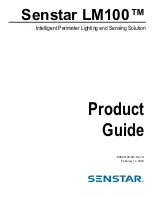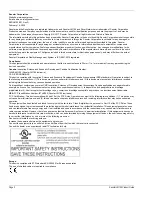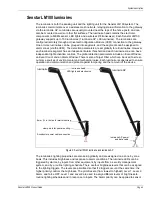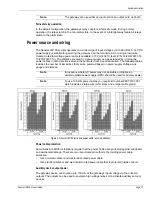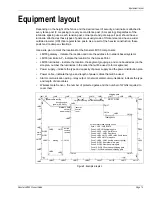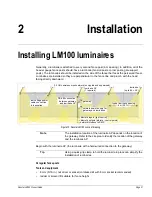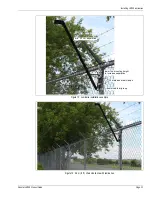
System description
Page 8
Senstar LM100 Product Guide
For optimum performance and the highest probability of detection (Pd) the Senstar LM100
luminaires can be mounted on fences up to 3.6 m (12 ft.) high, with up to 6 m (20 ft.) separation
between luminaires. With 6 m spacing between luminaires, one Senstar LM100 system can
protect up to 600 m (1970 ft.) of perimeter fencing. The luminaires can be mounted at various
heights on the fence posts to avoid contact with barbed wire outriggers at the top of the fence.
The Senstar LM100 system can protect most types of fences with user-configurable detection
parameters and light activation controls. Each system supports up to 50 distinct alarm zones and
each alarm zone can include from 1 to 100 luminaires. In addition to alarm detection and
response, each software defined zone can follow a preset schedule for routine light activation. The
luminaire detection parameters and alarm response are configured through the LM100 gateway.
The lights can be turned ON, OFF, and Strobed in response to an alarm, individually or grouped by
zone. The luminaires can also have their brightness adjusted for routine lighting and alarm
response.
The LEDs on the Senstar LM100 luminaires are optimized to provide full spectrum lighting to
ensure high quality images for CCTV coverage. The LEDs provide uniform directional lighting
along the fence line with an elliptical 120º coverage pattern that minimizes light pollution. The LED
lights are fully ON or OFF instantly, without a warm-up period and each luminaire consumes only
2.5 W. There are four priority lighting levels that can be assigned to the luminaires, with the
brightness of each level set globally.
The Senstar LM100 gateway includes ten I/O ports that are individually selectable as inputs or
outputs with normally open or normally closed contacts. An I/O option card can be added to the
gateway to provide an additional 4 inputs or 4 outputs. The I/O points can be controlled locally by
the gateway with the outputs used to signal alarm and supervision conditions, and the inputs used
to activate luminaire zones. Alternately, the I/O points can be controlled remotely by a security
management system (SMS). In this case the outputs are used to activate auxiliary equipment and
the inputs are used to communicate the status of auxiliary devices to the SMS. The outputs are
individually configurable and can source, up to 100 mA to power auxiliary equipment. The inputs to
the gateway must be voltage free. The Senstar LM100 supports the Wireless Gate Sensor (WGS)
to provide security coverage for up to 4 gates per system. The WGS requires a receiver module
which mounts on the gateway circuit card assembly (CCA) and at least one gate sensor for each
protected gate.
The Senstar LM100 system can operate as a standalone system which reports alarm conditions
via contact closure outputs. Each luminaire can be configured to respond to alarm conditions, to
automatically turn ON and OFF according to a user-defined schedule, and to activate other
equipment (via gateway outputs). Each luminaire can also be configured to respond to dry contact
inputs from other equipment such as a photo cell for routine light activation.
The Senstar LM100 can be part of a Silver Network based security system. In this case the
gateway requires a network interface card (NIC) that connects to a PC running Senstar’s Network
Manager (NM) service. The NM interfaces seamlessly between the Senstar LM100 and a security
management system such as Senstar’s StarNet 2 or Alarm Integration Module. In addition, the
Network Manager functions as a data server which collects and distributes alarm point data and
control point status for third party Security Management Systems (SMS) via the Network Manager
Interface. The Senstar LM100 can easily be integrated into any SMS that accepts contact closure
outputs. There are 16 RF channels available to prevent mutual interference between closely
located Senstar LM100 systems (i.e., LM100s operating within 400 m of each other).
Note
It is possible for the Senstar LM100 to protect fences higher than 3.6 m
by reducing the luminaires mounting height, and/or installing a luminaire
on every fence post (using 3 m spacing). However, Senstar strongly
recommends installing and testing a scaled-down Senstar LM100
system on higher fences to verify the sensor meets the site’s detection
requirements before installing a complete system.

